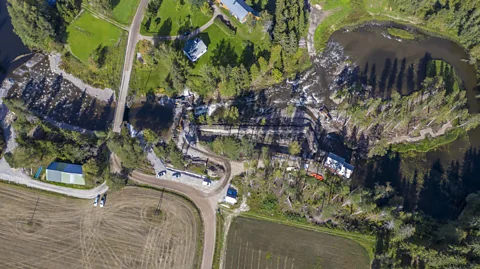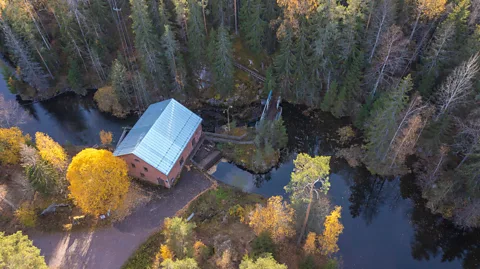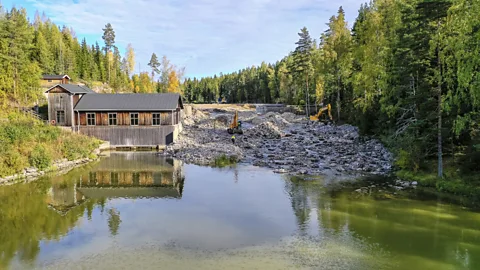Why Europe is dismantling its dams
 Mikko Nikkinen / Storymakers 2021
Mikko Nikkinen / Storymakers 2021Artificial barriers have long blocked Europe's waterways. But as many of these structures age, a movement is growing to let rivers flow freely once again.
Three years ago, when construction workers started demolishing a series of dams on the Hiitolanjoki River in Finland, they were greatly surprised to spot a run of salmon. Part of the country's last wild and landlocked population, the fish were returning to the river after years of absence. For Pauliina Louhi, it was a sign that the ecosystem's recovery had begun.
"It was not only adults – there were many salmon juveniles," Louhi, an ecologist at Natural Resources Institute Finland, a Finnish research organisation, recounts enthusiastically. "They had already been spawning on the lowermost part of the river. When I saw how the site looked after the dam removal, I actually had tears in my eyes."
The river used to be a key migration route for the endangered freshwater salmon from Lake Ladoga, in nearby Russia, to Finland. But between 1911 and 1925 the introduction of three dams supplying hydroelectric energy created barriers between the salmon and their spawning grounds. The salmon and other fish, like brown trout, were trapped on the Finnish side of the river, which remained fragmented for 100 years.
Today, however, with the dams removed, the water runs freely once again through newly built rapids surrounded by tall trees. Every time a dam was removed, salmon "embraced" the new part of the river, says Hanna Ollikainen, executive director of the South Karelian Recreation Area Foundation, a civil society organisation, which acquired the dams and is responsible for the environmental and touristic development of the area. In 2021, after the first removal, five spawning nests were spotted; in autumn 2022, one year on, baby salmon reached a record-breaking number of 200 fish per acre (0.4 hectares). When the removal of the upmost dam, Ritakoski, was completed in December 2023, they found a free passage to the upper parts of the river and its tributaries.
The removal of the three dams was the result of decades of work, which took into consideration not only the health of the river, but also the economic context, says Ollikainen. Evaluations concluded that their electricity production had become unprofitable for the power plant owners – especially when the costs of maintenance and mandatory environmental protections, such as fish-ladder introductions, were taken into account, Ollikainen says. So the dams were sold and dismantled.
 Mikko Nikkinen / Storymakers
Mikko Nikkinen / StorymakersThe decommissioning of the three Finnish dams is not an isolated case, however. Across Europe, many dams are either approaching the end of their operational life, or the costs of their maintenance are outweighing the benefits they provide. Similarly, in the United States, many are due to be re-licensed, sparking discussions about whether they are still fit to yield services. And it is not just big dams: millions of small barriers block European rivers.
Until recently, a comprehensive assessment of the extent of river fragmentation in Europe was lacking. But now it exists, the case for dam removal has been building.
A dam big problem
Rivers in highly industrialised areas, such as in Europe and the US, have been heavily modified for centuries, from road-crossings and water extraction for agriculture, to the addition of low barriers such as weirs, culverts, water mills and hydroelectricity. Just over a third of the world's rivers longer than 1,000 km (621 miles) still remain free-flowing over their entire length, according to estimates by researchers.
Sign up to Future Earth
Sign up to the Future Earth newsletter to get essential climate news and hopeful developments in your inbox every Tuesday from Carl Nasman. This email is currently available to non-UK readers. In the UK? Sign up for newsletters here.
Such barriers have created a series of problems. They not only cause biodiversity loss, impacting fish and microorganisms, but also prevent nutrients and sediments from flowing downstream, hindering fisheries and the livelihoods that depend on them. As dams block sediments behind them, the water downstream also has a highly erosive power. Plus barriers modify the water levels of the river, impacting the recharge of the aquifer that holds underground water.
The loss of river connectivity – which allows water, organisms and sediment to move across a watershed – modifies flow dynamics and temperature regime, explains Melissa Foley, science director of the resilient landscape programme at the San Francisco Estuary Institute. This alters nutrient dynamics.
Dams also create obstacles for species that migrate to reproduce – with the impact on fish populations particularly concerning. An update on the IUCN Red List of Threatened Species at the COP28 UN Climate Conference showed that 25% of the world's freshwater fish species are at risk of extinction – and that 45% of those threatened were negatively affected by dams and water extraction.
 Kim Birnie-Gauvin
Kim Birnie-GauvinNor it is not just migratory fish that are effected: the cumulative impact of barriers, even the smaller ones, limits movements of many other riverine fish along the watercourse, with research showing that fragmentation is one of the five main culprits for biodiversity loss.
But thanks to dam removal advocates, and more data on the detrimental effects and extent of river fragmentation, the tide is turning on support for dams.
Turning the tide on dam removal
Research now shows that at least 1.2 million instream obstacles block river flows in 36 European countries, with about 68% less than 2m (6.6ft) in height. "Even barriers as small as 20cm (8in) may impact or delay the movement of some organisms," says Carlos Garcia de Leaniz professor in Aquatic Biosciences at Swansea University and coordinator of Amber, a project that created the first atlas of European river barriers.
Since 2016, when the Amber project started, a team coordinated by Garcia de Leaniz have walked 2,000km (1,243 miles) of rivers across Europe to map their state of fragmentation. They have logged not just dams, but also weirs, culverts and other small blockades.
When it comes to actually removing a dam or barrier, several factors are relevant – from licencing and state laws, to funding for the engineering work and feasibility. Yet about 150,000 of Europe's interstream obstacles, such as dams, are now considered obsolete, according to Dam Removal Europe. Ageing dams need more maintenance, and are more exposed to the risks of collapse. Plus increasing extreme weather events, such as heavy precipitation, may also put dam safety at further risk of overtopping.
There are thus many examples of end-of-lifespan, obsolete dams in Europe, whose maintenance costs now outweigh the benefits of energy production, explains Pao Fernández Garrido, project manager of Dam Removal Europe, founded in 2016 as a coalition of seven partners. The European dam-removal movement has consequently achieved at least 325 removals in 2022, 36% more than the previous year.
 Mikko Nikkinen/Storymakers
Mikko Nikkinen/StorymakersAcknowledging that dams have a detrimental effect on ecosystems doesn't mean denying hydropower's benefits in supplying energy, however. "Absolutely nobody is proposing to blow up or remove barriers which are in use," clarifies Garcia de Leaniz, "We are targeting barriers which are obsolete, which are no longer providing any services to society, that have silted up, and pose a flow hazard."
Legislation can also help the dam removal process, though it differs from country to country. Spain, where rivers are public, is at the vanguard of dismantling dams in Europe, with 133 removals carried out in 2022, followed by Sweden and France. River connectivity is also a central topic of the European Commission's Nature Restoration Law: in November 2023, European member states reached a provisional agreement that includes an obligation to remove man-made barriers to reach a goal of 25,000km (15,530 miles) of free-flowing rivers by 2030. The law was then approved on the 27 February by the European Parliament. Dam removal advocates hope it will help make the case for more action.
Nor is Europe alone in this trend. In fact, the Europe efforts were inspired by the dismantling works already happening in the US, says Fernández Garrido. The US is home to nearly 92,000 dams with an average age of 62 years.
The first big dam removal in the US involved the Edwards Dam removal on the Kennebec river in 1999. Built in 1837, when the owner's licence expired in 1997, the Federal Energy Regulatory Commission didn't renew it, prioritising the ecological benefits of the river for the first time instead. Today, nearly 2,000 dams have been removed from US rivers, with 76% dismantled since the removal of the Edwards Dam.
How to remove a dam?
Dams don't often come down with an explosion and a sudden burst of water. Instead, removal is a meticulously planned engineering work. On the Hiitolanjoki River, bulldozers progressively excavated the concrete walls, letting the water gush out slowly.
"Understanding what you have behind the dam is part of the process," says Foley. "Where does the sediment end up? Does that change the flooding regime as well? Do you dig all of that sediment out? What are the mitigation strategies?"
Sometimes, when a dam can't be removed, it is equipped with a fish ladder. However, while useful to some fish, many species don't benefit, nor do they help with river dynamics and sediment flow. As dam removals can be expensive, researchers suggest concentrating on small barriers, prioritising the removals that can lead to the best increases in connectivity.
One of the largest river restoration projects to date has taken place in France on the Sélune River in Normandy. The removal of two large dams between 2019 and 2023, opened up 60km (37 miles) of the river. Operating since the 1920s, the two dams had entirely blocked the migration of Atlantic salmon, lampreys and European eels for a century.
As the reservoirs were slowly drained through heavy engineering work, the sediments accumulated behind the dam were used to rebuild the banks. "The vegetation grew back really quickly, the sediment was actually really rich in nutrients," says Laura Soissons, coordinator of the Sélune scientific programme at Inrae, which is monitoring of the project. "The vegetation helped stabilise the banks and bring shadow and shelter for a lot of species."
 OPP Sélune, Univ Paris Nanterre/SMBS
OPP Sélune, Univ Paris Nanterre/SMBSNor is it just the physical elements of dam removal that have to be carefully managed. The Sélune project suggests that communicating the reasons behind the removal is central success, since local populations can have strong attachments to the landscapes the dams create. "Showing people what a free-flowing river looks like can be challenging when these barriers have been in place so long," says Foley.
Before the removal work on the Sélune River, people living locally used the lakes behind the dams for numerous activities such as boating and fishing. But the reservoirs were blooming with toxic cyanobacteria. "By the end all those activities were all slowly dying because you couldn't swim anymore. The water was too toxic," says Jean-Marc Roussel, research director of the Sélune scientific programme at Inrae.
When fish ecophysiologist Kim Birnie-Gauvin at the Technical University of Denmark travelled to the Sélune River with other dam removal scientists, they were met by upset local citizens. Yet, on talking with the researchers, one man had an "eureka moment", Birnie-Gauvin recalls. "He realised his grandfather was probably [also] angry when the dam was built, and his landscape was changed as well," she says.
When the dams go, nature and people return
When dam removal is achieved, the results can be striking.
On the Sélune, not only did vegetation come back, but fish returned to parts of the catchment once unavailable to them. Following the removal of the second dam, some salmon arrived in the upstream part of the river and young salmon were spotted above the old dams after the winter 2022-2023 reproduction cycle. Similarly, European eels are now recolonising the entire catchment and sea lampreys are using the new habitats as spawning grounds.
Carbon Count
The emissions from travel it took to report this story were 0kg CO2. The digital emissions from this story are an estimated 1.2g to 3.6g CO2 per page view. Find out more about how we calculated this figure here.
For people too, dam removal is transformative. As well as the removal of toxicity, restored rivers have spearheaded tourism opportunities. At the Hiitolanjoki River, already a tourist spot, the area is poised to see a significant surge in visitors, says Ollikainen.
Similarly, in the US, removals have often resulted in people returning to rivers. Research shows that five years after the removal of the Penobscot River in the state of Maine, there was an increase in perceptions of water quality as well as in activities such as swimming, paddling and wildlife viewing. Moreover, restoring the river's free-flowing status had great cultural importance, with the Penobscot Indian Nation one of the main stakeholders in favour of the dam's removal.
At the beginning, the removal plan drew some scepticism, explains Joshua Royte, landscape ecologist and senior scientist at the Nature Conservancy, an NGO that is partnering on the dam removal project on the Penobscot river. Some people living locally were worried about losing the dam that some children called "grandma's waterfall", he notes. But since removal, the rapids have become a playground for boaters, a kayak competition was held and there are educational activities. "[people] love the river now even more," says Royte.
 Joshua Royte/The Nature Conservancy
Joshua Royte/The Nature ConservancyGoing against the flow
While Europe and the US are showing that barrier removal can be a viable option to restore river connectivity, there is still a long way to go however. Researchers are worried about the prospect of new dams planned along major rivers such as the Amazon, the Congo and the Mekong basin. Similar worries concern also the Balkans, where there are plans to build numerous small hydropower plants that research suggests will generate less power than a larger equivalent.
Removing barriers in Europe won't make sense if small, minimally effective hydropower dams are built elsewhere in the world, says Garcia de Leaniz.
"We need to look at the big picture: [small dams] are not going to produce a lot of electricity, and they are still going to cause a lot of damage," he says. "We should get rid of those barriers that are obsolete: it's not about removing all barriers, but removing the barriers that cause more damage than good."
--
If you liked this story, sign up for The Essential List newsletter – a handpicked selection of features, videos and can't-miss news delivered to your inbox every Friday.
You can also sign up to the Future Earth newsletter to get essential climate news and hopeful developments in your inbox every Tuesday from Carl Nasman. This email is currently available to non-UK readers. In the UK? Sign up for newsletters here.
